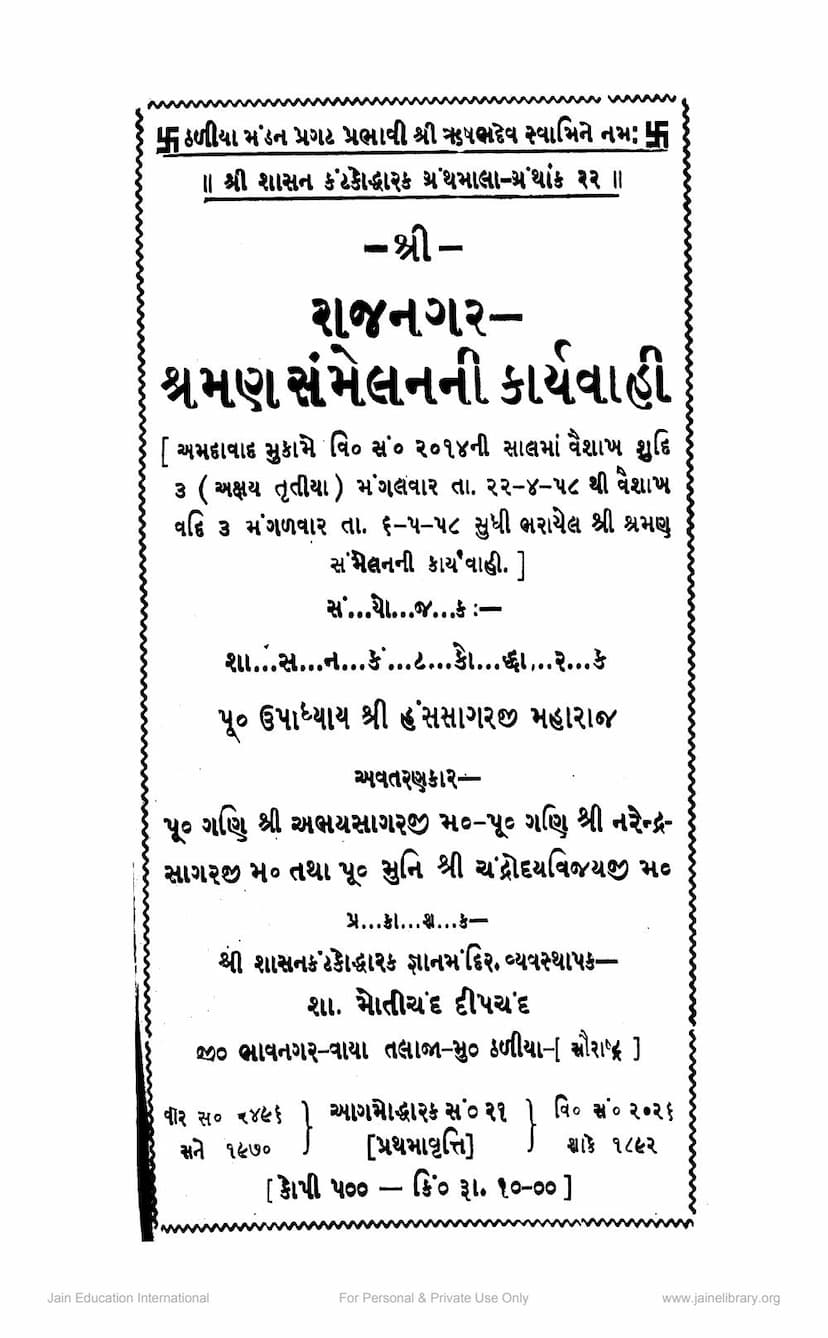Rajnagar Year 1958 Shraman Sammelanni Karyavahi
Added to library: September 2, 2025

Summary
Here's a comprehensive summary in English of the Jain text "Rajkot Year 1958 Shraman Sammelan Karyavahi" by Hanssagar, published by Shasan Kantakoddharak Gyanmandir:
Overview:
This document is the official record ("Karyavahi") of the Shraman Sammelan (Assembly of Jain Ascetics) held in Rajkot (Ahmedabad) from April 22, 1958, to May 6, 1958 (Vaisakha Shuddha 3 to Vaisakha Vid 3 of Vikram Samvat 2014). Authored by Upadhyay Hanssagarji Maharaj, the book details the proceedings of this significant gathering, which aimed to address crucial issues within the Jain community, particularly the Svetambara tradition. The text primarily focuses on the lengthy and often contentious discussions surrounding the accurate calculation and observance of Jain religious festivals and fasting days (Tithi discussions).
Key Themes and Content:
-
The Significance of Tithi (Date) Calculation:
- A central theme is the debate over the correct determination of Paryushana and other auspicious days, which are governed by complex astronomical and calendrical calculations.
- The text delves into the historical practices of the Tapa Gachha tradition, highlighting its adherence to ancient Jain principles and scriptures in calculating these dates.
- It discusses the adoption of external almanacs (Jainetar Tippanu) and the ensuing controversies when these clashed with Jain astronomical rules, particularly concerning the occurrence of Kshaya (waning) and Vruddhi (waxing) of Tithis.
- The document meticulously explains the scriptural basis for resolving these discrepancies, citing verses from Niryuktis and Churnis and the principles of Kshaye Purva and Udyat Tithi.
- It criticizes the adoption of certain practices deemed contradictory to scriptural purity and emphasizes the importance of adhering to the original Jain methods.
-
The Rajkot Shraman Sammelan:
- The document details the preparations, invitations, and attendee lists for the Sammelan, noting the participation of numerous Acharyas, Munis, Sadhvis, and lay followers.
- It describes the opening day's proceedings, including the welcome speeches by prominent lay figures like Seth Keshavlal Lallubhai and Seth Kasturbhai Lallubhai, who stressed the importance of unity and resolving the Tithi issue for the welfare of the Jain faith.
- The majority of the text is dedicated to the day-by-day accounts of the discussions, debates, and proposals put forth by various monastic leaders. These discussions reveal deep-seated differences in interpretation and practice regarding Tithi calculations.
-
The Debates and Dissensions:
- The proceedings reveal a significant divide within the Tapa Gachha itself, particularly between the followers of Acharya Vijaynandansuriji and Acharya Chandrasagar Suriji, concerning the Tithi issue.
- The text details the formation of committees, the reading of individual opinions and statements by various Acharyas, and the attempts to reach a consensus.
- There are instances of strong disagreements, the raising of objections, and extended discussions that highlight the complexity and sensitivity of the Tithi matter.
- The document records the specific arguments and counter-arguments presented, often referencing historical precedents, scriptural interpretations, and the authority of past Acharyas.
-
The Role of Lay Leaders:
- Prominent lay individuals like Seth Keshavlal Lallubhai and Seth Kasturbhai Lallubhai played a crucial role in organizing the Sammelan and facilitating the discussions, demonstrating their commitment to the Jain community's harmony and adherence to religious principles.
- Their interventions highlight the support and guidance provided by the laity in resolving doctrinal matters.
-
Specific Controversies and Their Resolution (or lack thereof):
- The text extensively details the debate surrounding the Tithi of Bhadrapada 4-5 (Bhadra 4-5). It recounts the historical context of resolving the Kshaya (waning) of the fifth Tithi and the subsequent differing opinions on how to maintain the continuity of the festival.
- The document mentions specific incidents, like the alleged misrepresentation of scriptures and the publication of controversial tracts, indicating the intensity of the debate.
- The detailed accounts of the discussions over several days show the slow and arduous process of deliberation, with multiple attempts to form committees and find common ground.
-
Historical Context and Scriptural Authority:
- The text frequently refers to ancient Jain scriptures, the teachings of past Acharyas, and the established traditions of the Tapa Gachha. This underscores the reliance on scriptural authority and historical precedent in resolving religious disputes.
- It emphasizes the importance of preserving the original purity and integrity of Jain practices.
Overall Significance:
The "Rajkot Year 1958 Shraman Sammelan Karyavahi" serves as a valuable historical document for understanding the internal dynamics and theological debates within the Svetambara Jain community in the mid-20th century. It provides a detailed, albeit lengthy, account of the efforts to unify the community on the crucial issue of Tithi observance, reflecting the deep reverence for scriptural accuracy and tradition among Jain ascetics and scholars. The document showcases the commitment of the community to maintaining the sanctity of religious practices and the challenges faced in adapting ancient principles to evolving interpretations and practices.